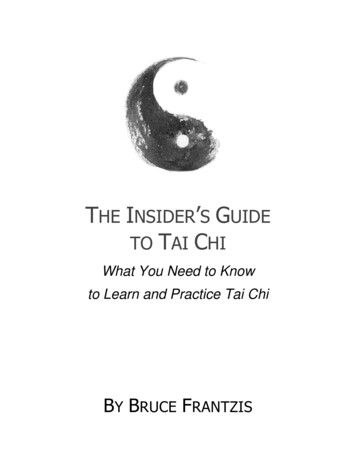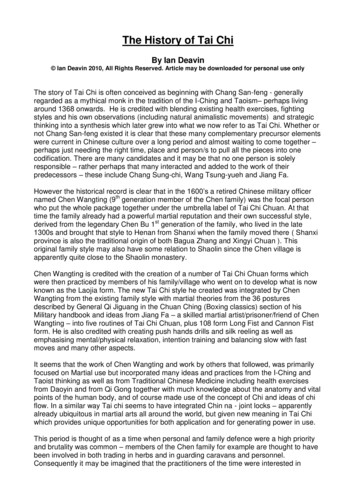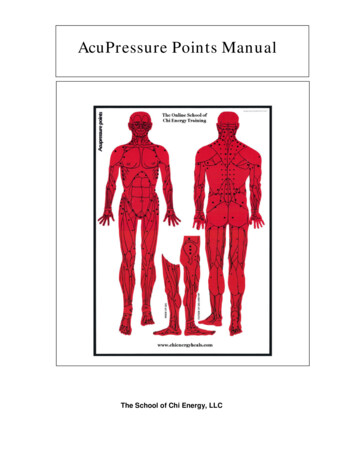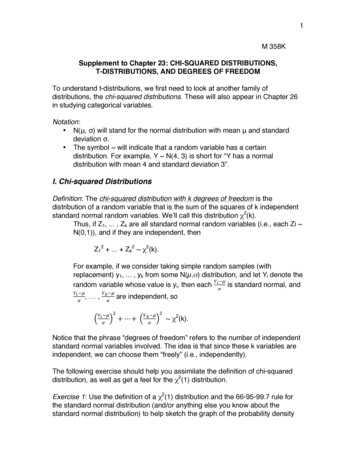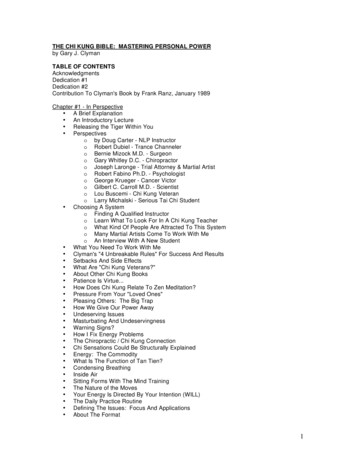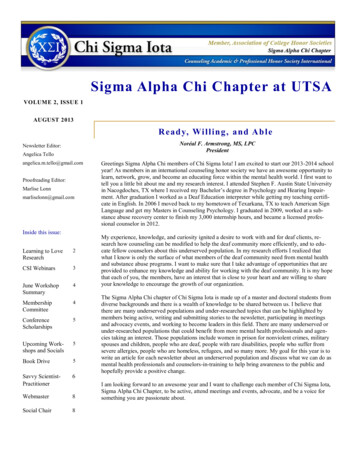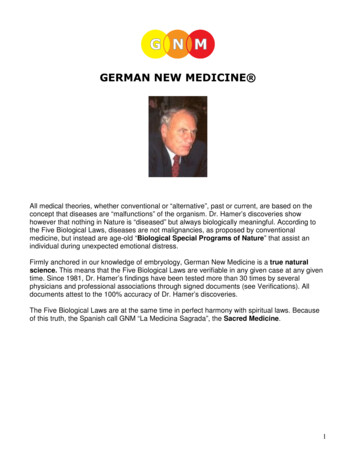
Transcription
GERMAN NEW MEDICINE All medical theories, whether conventional or “alternative”, past or current, are based on theconcept that diseases are “malfunctions” of the organism. Dr. Hamer’s discoveries showhowever that nothing in Nature is “diseased” but always biologically meaningful. According tothe Five Biological Laws, diseases are not malignancies, as proposed by conventionalmedicine, but instead are age-old “Biological Special Programs of Nature” that assist anindividual during unexpected emotional distress.Firmly anchored in our knowledge of embryology, German New Medicine is a true naturalscience. This means that the Five Biological Laws are verifiable in any given case at any giventime. Since 1981, Dr. Hamer’s findings have been tested more than 30 times by severalphysicians and professional associations through signed documents (see Verifications). Alldocuments attest to the 100% accuracy of Dr. Hamer’s discoveries.The Five Biological Laws are at the same time in perfect harmony with spiritual laws. Becauseof this truth, the Spanish call GNM “La Medicina Sagrada”, the Sacred Medicine.1
THE FIVE BIOLOGICAL LAWSFIRST BIOLOGICAL LAWThe First CriterionEvery SBS (Significant Biological Special Program) originates from a DHS (Dirk HamerSyndrome), which is an unexpected, highly acute, and isolating conflict shock thatoccurs simultaneously in the PSYCHE, the BRAIN, and on the corresponding ORGAN.In GNM terminology, a “conflict shock” or DHS refers to an emotionallydistressing situation that we could not anticipate and for which we were notprepared. Such a DHS can be triggered, for example, by an unexpectedseparation or loss of a loved one, unexpected anger or worry, or by a suddendiagnosis or prognosis shock. A DHS differs from a psychological “issue” oran everyday stress situation insofar as an unexpected conflict shock involvesnot only the psyche but also the brain and the body.From a biological point of view, “unexpected” implies that, unprepared for, the situation couldpotentially be detrimental for the one, who was caught off-guard. In order to assist the individualduring such an unanticipated crisis, a Significant Biological Special Program, created forexactly that particular situation, is instantly set into motion.Since these age-old meaningful survival programs are inherent in all organisms, including ushumans, we speak in GNM of biological conflicts rather than of psychological conflicts.Animals experience these biological conflicts in real terms,for example, when they lose their nest or territory, whenthey are separated from a mate or an off-spring, when theyare attacked by an opponent, when they suffer a threat ofstarvation or a death-fright.Sorrow over the loss of a mateSince we humans are able to interact with the world in literal and symbolic terms, we can sufferthese conflicts also in a figurative sense. For example, a “territorial loss conflict” can translateinto the loss of a home or a workplace, an “attack conflict” can be experienced through anoffending remark, an “abandonment conflict” can be caused by feeling isolated and excludedfrom ”the pack“, or a “death-fright conflict” can be triggered by a diagnosis shock that isperceived as a death-sentence.NOTE: Undernourishment, poisoning, or injuries can result in organdysfunction(s), without a DHS!2
Here is what happens in the psyche, the brain, and the corresponding organ, the moment aDHS takes place:LEVEL OF THE PSYCHE: the individual is emotionally and mentally in distress.BRAIN LEVEL: The moment the DHS occurs, the conflictshock impacts a very specific – predetermined - area in thebrain. The impact of the shock is visible on a brain scan(brain computer tomogram) as a set of sharp concentricrings.In GNM such a ring configuration on a brain CT is called aHamer Focus or HH (from the German: HamerscherHerd). The term was originally coined by Dr. Hamer'sopponents, who mockingly named these structures“dubious Hamer Foci”.Before Dr. Hamer identified these ring structures in the brain, radiologists considered them asartifacts created by a glitch in the machine. But in 1989, Siemens, a manufacturer of computertomography equipment, certified that these target rings cannot be artifacts because evenwhen the tomography is repeated and taken from different angles, the same configurationalways appears in the same location.The same type of conflict always impacts in the same brain relay.The exact LOCATION of the HH is determined by the nature ofthe conflict. For example, a “motor conflict”, experienced as “notbeing able to escape” or “feeling stuck”, impacts in the brain in themotor cortex that controls the muscle movements.The SIZE of the HH is determined by the intensity of theconflict.We could imagine each brain relay as a cluster of brain cells thatfunctions both as receptor and transmitter.ORGAN LEVEL: The moment the brain cells receive the DHS, the conflict shock is immediatelycommunicated to the corresponding organ and a “Significant Biological Special Program”(SBS), on stand-by for exactly that conflict, is instantly activated. The biological significance ofeach SBS is to improve the function of the conflict-related organ, so that the individual is in abetter position to manage and eventually resolve the conflict.3
Both the biological conflict and the biological significance of each Special BiologicalProgram (SBS) always relate to the function of the correlating organ or organ tissue.Example: If a male suffers a “territorial loss conflict”, the conflict impacts in the area of thebrain that controls the coronary arteries. At this moment, the arterial wall lining begins toulcerate (causing angina pectoris). The biological purpose of the tissue loss is to widen thelumen of the heart vessel, so that more blood per minute can be pumped to the heart, whichgives the male more energy and more vigor in his effort to get his territory (his lost home orworkplace) back or to establish a new one.This meaningful interplay between the psyche, the brain, and the body has been in place formillions of years. Originally, these innate biological response programs were directed from the“organ brain” (every plant still possesses such an organ brain). With the growing complexity oflife forms a “head brain” developed, from where each Significant Biological Special Program(SBS) is now coordinated and controlled. This biological transfer to the head brain explains whythe brain control centers of each organ are arranged in the same order as the organs inthe body.Example: The brain relays that control the skeletal structure (bones) and the striatedmusculature are distinctly arranged in the cerebral medulla (the interior part of the cerebrum).This diagram shows that the control centersfor the calotte (skull), arms, shoulders,vertebrae (spine), pelvis, knees, and feet areall arranged in an orderly fashion, virtuallyfrom head to toe (like an embryo on its back).The biological conflict theme linked to thebones and the muscle tissues are “selfdevaluation conflicts” (related to a loss of selfesteem, of feeling “worthless” or “useless”).Since there is a cross-over correlation fromthe brain to the body, the brain relays on theright hemisphere control the bones andmuscles of the left side of the body, whereasthe brain relays on the left side control thebones and muscles of the right side of thebody.This remarkable organ CT, showing an active HH in thearea of the 4th lumbar spine (active “self-devaluationconflict”), makes the communication between the brainand an organ strikingly visible.The Second Criterion4
The Second CriterionThe conflict content determines the location of the HH in the brain and where exactlyon the organ level the related SBS will run its course.The conflict content is determined at the very moment of the DHS. When the conflict occurs, oursubconscious associates in a split of a second with the event a very particular biologicalconflict theme, e.g., “loss of the territory”, “worry in the nest”, “abandonment by the pack”,“separation from a mate”, “loss of an off-spring”, “attack by an opponent”, “threat of starvation”,and so forth.If, for example, a woman is unexpectedly faced with a separation from her partner, this does notnecessarily mean that she suffers a “separation conflict” in biological terms. The DHS can alsobe experienced as an “abandonment conflict” (affecting the kidneys, or a “self-devaluationconflict” (affecting the bones, resulting potentially in osteoporosis, or a “loss conflict” (affectingthe ovaries). Also, what one person experiences as a “self-devaluation conflict”, can beexperienced quite differently by another person. For a third person the event could be totallyirrelevant.It is our subjective feeling behind the conflict and our individual perception of theconflict that determines which part of the brain will receive the shock and,consequently, what physical symptoms will manifest as a result of the conflict.One single DHS can impact more than one brain area, resulting in multiple “diseases”, such asmultiple cancers, erroneously called metastasis. For example: If a man unexpectedly lost hisbusiness and the bank takes all his assets, he can develop colon cancer as a result of an“indigestible morsel conflict” (“I can’t ‘digest’ this!”), liver cancer as a result of a “starvationconflict” (“I don’t know how to provide for myself!”), and bone cancer as a result of a “selfdevaluation conflict” (a loss of self-esteem). With the resolution of the conflict all three cancerswill go into healing at the same time.The Third CriterionEvery SBS-Significant Biological Special Program runs synchronously on the level ofthe psyche, the brain, and the organ.The psyche, the brain, and the corresponding organ are three levels of ONE unifiedorganism that always works in synchronicity.5
BIOLOGICAL LATERALITYOur biological handedness determines in which of the two brain hemispheres the conflict willimpact and which side of the body will be affected. Our biological laterality is decided at themoment of the first cell division after conception. This is why with identical twins, one isbiologically right-handed and one is left-handed. The ratio of biologically right-handed and lefthanded people is approximately 60:40.The biological laterality can easily be established with the clapping test. The hand that ison top is the leading hand and tells whether a person is right-handed or left-handed.The rule of laterality: A right-handed person responds to a conflict with his/her mother or childwith the left side of the body and to a conflict with a partner (anybody except mother or child)with the right side. With left-handed people it is reversed.Example: if a right-handed woman suffers a“worry conflict” over the health of her child, shewill develop a glandular breast cancer in herleft breast. Since there is a cross-overcorrelation from the brain to the organ, on abrain scan, the corresponding HH will be foundon the right hemisphere in the part of the brainthat controls the glandular tissue of the leftbreast.If the woman were left-handed, the “worryconflict” over her child would manifest as acancer in the right breast, showing the impacton a brain-CT on the left brain hemisphere, inthe cerebellum.Establishing the biological laterality is of utmost importancefor identifying the original DHS.6
THE SECOND BIOLOGICAL LAWEvery SBS-Significant Biological Special Program runs in two phases providedthere is a resolution of the conflict.NORMOTONIA refers to the state of our normal day-night-rhythm. As shown in the diagramabove, "sympathicotonia" alternates with "vagotonia". These terms relate to our autonomicnervous system (ANS) which controls vegetative functions such as the heart beat or digestion.During the day, the organism is in a normal sympathicotonic state of stress ("fight or takeflight"), during sleep in a normal vagotonic state of rest ("rest and digest").THE CONFLICT ACTIVE PHASE (ca-phase; sympathicotonia)As soon as a conflict shock (DHS) occurs, the normal day-night-rhythm is instantly interruptedand the entire organism enters the conflict-active phase (ca-phase). At the same time, theSignificant Biological Special Program (SBS) that correlates to the particular conflict isactivated, allowing the organism to override everyday functioning in order to assist the individual- on all three levels - during the particular crisis.LEVEL OF THE PSYCHE: Conflict-activity manifests itself as constant dwelling over theconflict.The autonomic nervous system is in lasting sympathicotonia. Typical symptoms aresleeplessness, a lack of appetite, a fast heart beat, elevated blood pressure, low blood sugar,and nausea. The conflict-active phase is also called the COLD phase, because during stressthe blood vessels are constricted, which results in cold hands and cold feet, a cold skin, chills,shivers, or cold sweats. From a biological point of view, however, the state of stress, particularlythe extra waking hours and the total preoccupation with the conflict, put the individual into amore favorable position to find a resolution to the conflict.BRAIN LEVEL: The location where the conflict impacts in the brain is determined by the exactnature of the conflict. The size of the HH is always proportional to the conflict's duration andintensity (conflict mass).7
During the ca-phase, the HH appears on a brain scan as sharpconcentric rings.The brain-CT picture shows a HH in the right hemisphere of themotor cortex, indicating that the related motor conflict ("notbeing able to escape") with paralysis of the left leg is stillactive. In a left-handed person, the motor conflict would beassociated with a partner-related conflict situation.The biological significance of the paralysis is a "fake-dead"reflex, because in nature a predator often attacks a prey onlywhen it tries to escape. Thus, the inherent response is: "Since Ican't escape, I play dead", causing paralysis until the danger isover. We humans
artifacts created by a glitch in the machine. But in 1989, Siemens, a manufacturer of computer tomography equipment, . For example: If a man unexpectedly lost his business and the bank takes all his assets, he can develop colon cancer as a result of an “indigestible morsel conflict” (“I can’t ‘digest’ this!”), liver cancer as a result of a “starvation conflict” (“I don .
